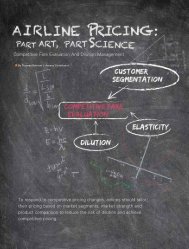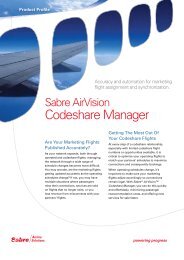2009 Issue 1 - Sabre Airline Solutions
2009 Issue 1 - Sabre Airline Solutions
2009 Issue 1 - Sabre Airline Solutions
You also want an ePaper? Increase the reach of your titles
YUMPU automatically turns print PDFs into web optimized ePapers that Google loves.
Enterprise business intelligence shows<br />
what’s going on in your business and<br />
helps plan business strategy, react<br />
to changes and monitor success. During<br />
the course of business, you can only know<br />
what direction and how fast you’re going in<br />
relation to where you are and where you’ve<br />
been. That is a fundamental concept behind<br />
the use of business intelligence systems,<br />
which can be extremely beneficial to airlines<br />
that utilize them from providers specifically<br />
designed for the air transport industry (see<br />
related article on page 70). Even though BI<br />
incorporates a lot of technology, the business<br />
view of BI is most critical because if<br />
you don’t know what’s going on in your business,<br />
you may be going out of business.<br />
As with any type of industry, business<br />
intelligence systems can be effectively<br />
applied to the travel and airline businesses.<br />
BI systems can help in many areas including<br />
cost control, revenue enhancement,<br />
customer engagement/satisfaction and<br />
marketing effectiveness. While transaction<br />
systems (online transaction processing) are<br />
needed to perform business functions and<br />
capture data from those transactions, BI is<br />
required to understand the context of the<br />
transactions and the effectiveness of business<br />
decisions as well as to provide insight<br />
into planning for the future.<br />
So what exactly is business intelligence?<br />
According to Forrester Research,<br />
Inc., BI is a set of methodologies, processes,<br />
architectures and technologies<br />
that transform raw data into meaningful<br />
and useful information. And Gartner, Inc.,<br />
breaks it down even further by separating<br />
BI into information delivery and analysis.<br />
Information delivery includes reporting,<br />
dashboards, ad hoc query and Microsoft<br />
Office automation. Analysis covers online<br />
analytical processing, advanced visualization,<br />
predictive analytics, data mining and<br />
scorecarding.<br />
This list is indicative of the different<br />
aspects of BI. There are two primary categories:<br />
reporting and analysis. Traditional<br />
BI tools have been used for reporting, which<br />
usually identifies what has happened in the<br />
past. For example, it is important to know<br />
how many passengers there were yesterday,<br />
last week and last month as well as<br />
how much revenue was generated. This can<br />
be expanded to compare the number of passengers<br />
last month versus the same month<br />
the previous year. This type of reporting<br />
then generates further questions such as:<br />
Why would the number of passengers<br />
change last month versus the same<br />
month last year?<br />
What were the frequent flyer demographics<br />
of the passengers?<br />
What were the advanced-purchase characteristics?<br />
Do those demographics and characteristics<br />
differ based on the origin-and-destination<br />
cities?<br />
As these questions continue to<br />
arise, more in-depth analysis of the data<br />
is required, which leads to more data to<br />
analyze as well as different ways to analyze<br />
and view the information generated.<br />
How Does It Work?<br />
Capturing data is the first key to an<br />
effective business intelligence solution. The<br />
transaction systems used to run the business<br />
(shopping, point of sale, passenger<br />
check-in, etc.) provide data sources for BI<br />
systems. Data is usually collected in a data<br />
warehouse system using extract/transform/<br />
load, or ETL, processes. The transformations<br />
are used to apply business rules to<br />
make the data more understandable from<br />
a business rather than technical perspective.<br />
It is important that these data warehouse<br />
systems are on separate database<br />
infrastructures from the online transaction<br />
processing systems because of the different<br />
tuning, processing and data retention<br />
requirements. Using an enterprise data<br />
warehouse method (where all required<br />
data is collected in one system) provides<br />
the data management features required<br />
to provide “one version of the truth” for<br />
reporting and analysis. A representative list<br />
of DW vendors includes Oracle, IBM-DB2,<br />
Microsoft-SQL Server and Teradata. A new<br />
and interesting entrant into this DW space is<br />
data warehouse appliances, which includes<br />
Netezza, Greenplum Network, Microsoft-<br />
DATAllegro, Oracle and Teradata.<br />
Business Intelligence tools<br />
The most commonly used data<br />
reporting tool is Microsoft Excel, but since<br />
Excel is an independent desktop tool, it<br />
presents many deployment challenges,<br />
most of which can be overcome by using<br />
business intelligence tools specifically<br />
developed for data reporting and analysis.<br />
The BI tools (for example, SAP-Business<br />
Objects, IBM-Cognos, MicroStrategy,<br />
etc.), in conjunction with the DW system,<br />
can be architected to provide development,<br />
test and production environments<br />
where processes can be implemented to<br />
ensure information quality (completeness,<br />
consistency, accuracy and timeliness).<br />
As can be surmised from Gartner’s<br />
classification of information delivery and<br />
analysis, more than one BI solution may<br />
be required to accommodate every business<br />
need. Even though one enterprise<br />
tool may be a goal, in many cases, this<br />
goal cannot be achieved because of previous<br />
purchase decisions, business unit<br />
independence, cost restrictions or tool<br />
capabilities.<br />
As a BI application expands to include<br />
many aspects of reporting, analysis, dashboards,<br />
data visualization, etc., one vendor’s<br />
BI tools may not provide the “best in<br />
class” for all aspects of the requirements.<br />
However, trying to integrate and manage<br />
different tools from multiple vendors may<br />
be more than some companies are willing<br />
to attempt.<br />
Two other options that exist for BI<br />
application development include newer<br />
open-source tools (such as Jaspersoft and<br />
Pentaho) and programmatic development<br />
(using Java, Visual Studio or other programming<br />
languages). Both of these alternatives<br />
to using traditional BI tool suites may<br />
require developers with different skill levels<br />
and different support requirements for managing<br />
the BI products.<br />
the future of BI<br />
While many businesses are at the<br />
early stages of adoption of traditional BI<br />
capabilities, others have begun to deploy<br />
more advanced methods as the BI industry<br />
and business requirements continue to<br />
develop. To understand your business, it<br />
is important to be able to report on what<br />
happened in the past and analyze why<br />
these things happened. BI reporting and<br />
analysis tools can provide these capabilities.<br />
However, being able to make reliable predictions<br />
of what will happen under certain business<br />
conditions and being able to influence<br />
the outcome of business/customer interaction<br />
is also an important capability that can<br />
be provided by certain BI processes such as<br />
data mining and predictive analytics.<br />
New areas of investigation include<br />
operational BI and business performance<br />
management. Operational BI uses traditional<br />
BI methods, concepts and tools to<br />
report and analyze near real-time data. This,<br />
of course, requires access to real-time data<br />
feeds that can require different data source<br />
and ETL methods. Business performance<br />
management is considered a next-generation<br />
BI solution that integrates a broader<br />
scope of a company’s data, including sales<br />
transactions, human resource information,<br />
financial data and any other relevant business<br />
data.<br />
The overriding point to consider for<br />
investment in business intelligence development<br />
is that BI processes are an integral<br />
part of business management, process<br />
improvement and business success. a<br />
Michael Embry is business intelligence<br />
architecture and development<br />
manager for <strong>Sabre</strong> Holdings ® .<br />
He can be contacted at michael.<br />
embry@sabre-holdings.com.<br />
ascend 37<br />
industry
















